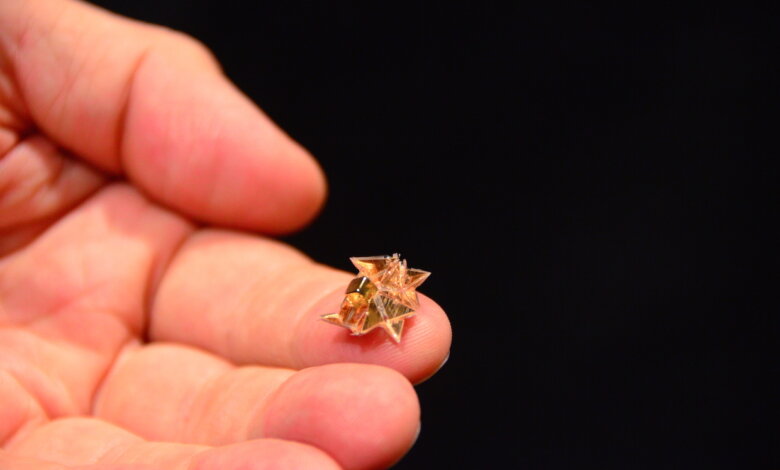MIT Unveils Tiny Foldable Drone That Can Dissolve

Massachusetts Institute of Technology has shown off its new and unusual design for a drone that can be folded and dissolved.
The drone weighs just one third of a gram and is a tiny 1.7cm long, it starts its life as a thin and flat wafer of polystyrene or paper with a magnet and PVC sandwiched between two layers. Almost as if by magic, when a gentle heat source is used to activate the drone, it folds itself into a complex shape and then begins moving or swimming around at a speed of 3cm per second. The robot is able to fold as the PVC at its core contracts, and folds are created where the layers have been cut or scored. The process of folding takes less than a minute for the tiny robot.
The drone is powered by magnets which can control movement and direction. There’s a neodymium magnet manufactured into the robot and four electromagnetic coils that sit under the operating surface which attract and repel the neodymium magnet. The electromagnets turn on and off at a rate of 15Hz, which causes the magnet on the drone to rattle and vibrate. This drives the feet and moves the drone forwards.Once the robot has been finished with, it can be dropped into a volume of acetone to dissolve the external structure completely, leaving just the magnet.
The drone was recently unveiled at ICRA in Seattle by the MIT team, led by Shuhei Miyashita. Described as a miniature origami robot that self-folds, walks, swims and degrades, this is the first time that a robot or drone has had a whole life cycle. Although the robot can move without assistance it does need to be operated on the specific surface containing the electromagnetic coils and these create the magnetic fields that determine where the robot goes.
The robot must be folded for it to be able to walk as the magnetic fields cause the front and back legs to alternately contact the operating surface and an asymmetrical design, along with an off center balance point, move it forward as it performs the tiny, quick jumps. In using the tiny origami robot, the MIT team have been able to create a floating device that is able to perform tasks like digging. The main robot they showcased at ICRA was a multitasking design, but they’re able to create different designs for different tasks with multi-stage folding.
After use, the robot can be made to march itself into a pool of acetone to dissolve itself except for the magnet. At the moment, only the structural outer layer can be made out of a material that dissolves in water, but the MIT team think that it may be possible in the near future. They also hope to be able to place self- folding sensors on the robots which will allow them to operate autonomously.
MIT hopes that these robots will be able to fold and operate inside your body in the future, before dissolving completely. This may allow the drones to perform small or routine operations, reducing the amount of trauma that patients sustain. However, the folding mechanism may be the only part of these robots that remains by the time the tiny wobbling robots are tested in human bodies as there are many changes that need to be made before they could perform any sort of duty inside a human. They would have to work autonomously but would also need to be programmed so that they would know where they’re going and when. It’s also not clear whether external electromagnetic coils would be able to control a robot inside a body. Finally, to make these useful, the robots need to be able to do more than just walk or swim so it must be decided what jobs they’ll do in the body and how they’ll do them.
The self-folding origami robot may reach the medical field in some kind of capacity in the future, but until then it is projects like these that push technology and ideas forward and allow scientists and researchers to work on brand new designs that can shape the progression of science.





